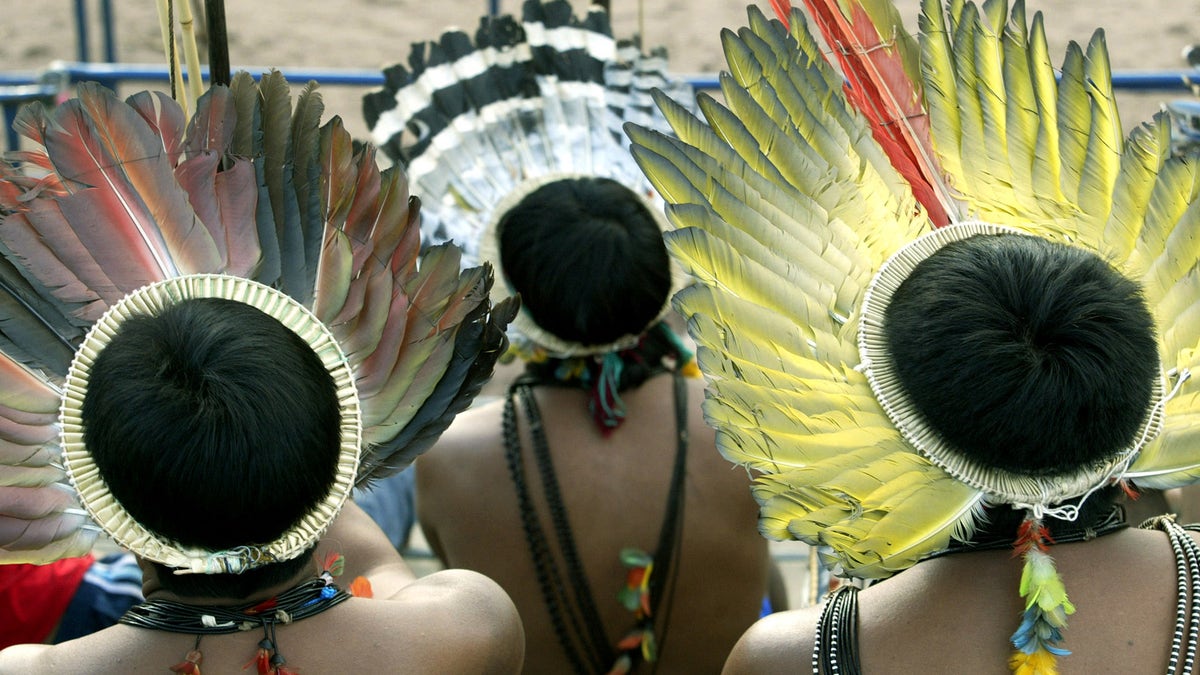
File photo. Members of the Brazil's Surui nation, wearing their traditional 'Cokar,' handmade with plume of macaw, watch the VI Indigenous Nation's Games competition in Palmas, northern Brazil, November 5, 2003. (REUTERS/Paulo Whitaker)
It’s a well-known theory that the first Americans crossed the Bering land bridge from Siberia to Alaska at some point less than 23,000 years ago. However, new research from deep within the Amazon suggested that a mysterious, previously unknown “ghost population” crossed over at some point as well. According to a new report in the online journal Nature, DNA evidence has revealed that two Amazonian tribes – the Surui and the Karitiana – are more closely related to Papua New Guineans and Aboroginal Australians than they are to Native Americans.
This would mean that their ancestors, or “Population Y,” also crossed the land bridge before being replaced by the First Americans in North and South America.
Lead study author Pontus Skoglund of the Department of Genetics at Harvard Medical School and his team made the unexpected discovery by using statistical methods that test whether a set of populations are equally related to a set of other populations.
“If Native Americans are all from a single ancestral stream that peopled the Americas, this is expected to hold true,” Skoglund told Foxnews.com. “What we found instead was that there was a special genetic link between Amazonian populations in Southeast Asian islanders. This suggests a more diverse set of founding populations of the Americas then we had genetic evidence for previously.”
The genetic evidence indicates that current Australasians (people in the general geographic area that is now Australia, New Zealand, the island of New Guinea, and neighboring Pacific islands) are descended from a group of humans who once lived widely across Asia. Skoglund and his team believe this ancestry no longer exists in Asia, and that the “ghost population” was overwritten later once it crossed the Bering Land Bridge.
What happened to Population Y — derived from the word “Ypykuera,” which means “ancestor” in the language spoken by the Surui and Karitiana people — after they crossed over remains a mystery.
“We think that ‘Population Y’ was one of several pulses that came from the Northeast to populate the Americas,” Skoglund suggested. “Perhaps the different pulses interbred very early during the peopling, or perhaps later on.”
He also noted that this lineage traces back to Native American ancestry today. So, it did not disappear entirely.
Another unknown factor is when they crossed over exactly. While Skoglund and his team believes Population Y came to the Americas more than 15,000 years ago, researchers from the Natural History Museum of Denmark in Copenhagen — who also noticed the unexpected link between Americans and Australasians while studying the timing of humans’ migration across the Bering land bridge — believe that they crossed over less than 9,000 years ago. Having discovered traces of Australasian DNA in current Aleutian islanders living off the Alaskan coast, they posit that Aleutian DNA was introduced into other Native American groups some time after the islands were first settled.
While Skoglund disagrees with their assessment, he said that both timelines are possible.
“The archaeology seems to make quite clear that there is one big push into the Americas about 15,000 years ago, but in my opinion, neither we nor other researchers can be sure of when this source population arrived,” he added. “We can speculate that it might have followed the coast, or came earlier or after other pulses. Both these options as well as others are, in principle, possible.”
To find the answer, Skoglund and his team will need to sample more ancient genomes from the Amazon, which is no easy task. For one thing, the region’s climate makes it one of the worst places in the world for DNA preservation.
“DNA starts to break down after we die, but this process is slower in cold and dry climates,” Skoglund explained. “The Amazon is hot and humid, and so the climate is not so favorable for the DNA molecules to be preserved.”
Sampling DNA from parts of the Americas and Siberia — Population Y’s presumed stomping grounds — should be much easier.
